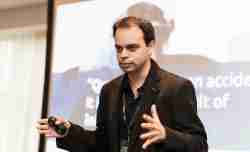A civilization is defined as an advanced stage of human society, where people live with a reasonable degree of organization and can think about things like art and education.
DevOps is the Mount Olympus of the new software delivery civilization: an advanced stage of software delivery where multi-skilled and diverse professionals cocreate software through a reasonable degree of organization (agile mindset, creation pipeline, quality gates, and integrated tools) and comfort (measurement, accelerators, automation, processes efficiency, traceability,…) and can think about things like user experience and quality.
In the Mount Olympus of DevOps, Quality Assurance is a must and it may adopt many forms (functional, performance, security, usability…) at different levels of power (unit, integration, end-to-end…). This is why we emphasize it as Dev(QA)Ops with the main objective: the purpose is to deliver fast and with higher levels of quality, understanding quality as everything that may prevent defects when the software is delivered, from the different perspectives that a user may perceive.
And in the Mount Olympus of Dev(QA)Ops we have also the Twelve Olympians:
- Zeus. In DevOps, we need leadership (with processes, people and technology focus) and governance. New contributions need to be managed by means of an orchestrated pipeline that manages (as much automatically as possible) new software contributions, checks if the quality gates detect potential defects and push them to progress to the production environment.
- Hera. As family values are important, also team values and organization are critical for DevOps. This is why the main driver for DevOps is the agile mindset with a one-time vision aimed at cocreate value. I recently write a whitepaper about the agile mindset for details.
- Poseidón. As the water in the sea flows, new software contributions in a DevOps workspace need to flow from code to production through a pipeline that coordinates, for each new software commit/merge proposal, a sequence of actions (compilation, environments creation, Test Data Management….), quality gates (code analysis, testing, metrics thresholds..) and, if all gates are passed, deployment to each environment. This pipeline is the technological and tool-based process to support agility and continuous delivery.
- Apolo. As music and fine arts are based on creativity, open-mind, and cocreation, the artifacts (user stories, code contributions,…) in DevOps need to be based on cocreation performed by different specialized and multi-skilled roles (business, developers, testers, UX experts, architects, building engineers,…) from the beginning of projects. Moreover, Continuous Integration (CI) needs to be applied through a systematic code branches/commits/merges approach with clear policies.
- Atenea. Wisdom is the base for efficiency. This is why it is also crucial to incorporate the wisdom and artificial intelligence to DevOps pipelines in order to facilitate and improve decisions (automatically based on data analysis and prediction), to selectively decide “on the fly” the quality gates to be activated and to make progress smoothly through the DevOps pipeline.
- Afrodita. Beauty and desire are human experiences, in DevOps we need to aim for achieving a better user experience and reactions. And this is, in short, pushing for software quality. This is why, further than becoming agile, we need to take care of quality from all different perspectives that may affect the perception of users in each project.
- Ares. The main driver for the strength of robust DevOps work environments is automation. Analyzing the software creation process and adding automation strategies with an end-to-end vision is essential.
- Dionisio. Celebrations for what we are able to deliver are also essential. This is why agile ceremonies, passion and inspiration need to find their place in DevOps.
- Hermes. In DevOps, professionals need to communicate, but also tools that are integrated into the pipeline notify and interact with other tools and professionals. This is why we need a centralized communication channel with communication policies. The approach of ChatOps (using a chatbot channel for high-level interaction and communication for all professionals and tools) is gaining popularity in order to address this challenge.
- Artemisa. A DevOps work environment needs to be data-driven. We need to hunt data that is generated during iterations by following a 360-degree vision and use it for evaluating the evolution of quality iteration-by-iteration through a centralized dashboard of the main quality metrics that are going to govern the evolution of software development.
- Hefesto. As artisans and smiths need fire to shape the iron, DevOps professionals need to cultivate a high passion for technology and specialized technical skills. This the so-called T-Shaped profile.
- Demeter. As fertility depends on the pass of time and the seasons, in DevOps the deployment to the different environments and the final deployments to production can be automated (or at least in some cases, semiautomated). Cloud and architectural approaches play a key role in order to facilitate it.
The myth needs to inspire us to make it real. And Dev(QA)Ops is now an evolving reality which needs to be progressively applied as stated in the new World Quality Report Edition (*) Let’s be inspired and let’s make it happen through our Sogeti pragmatic approach. The era of the Dev(QA)Ops civilization is here.

 English | EN
English | EN 
